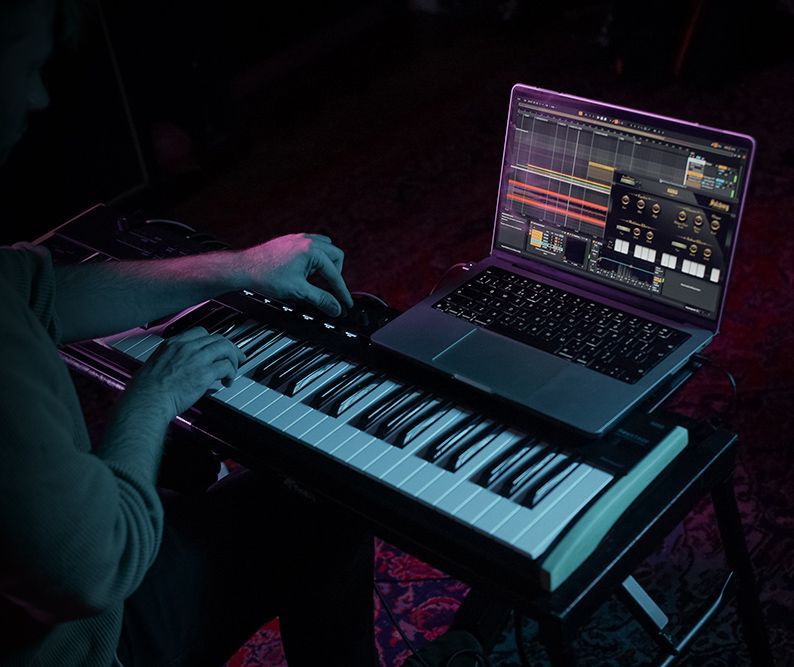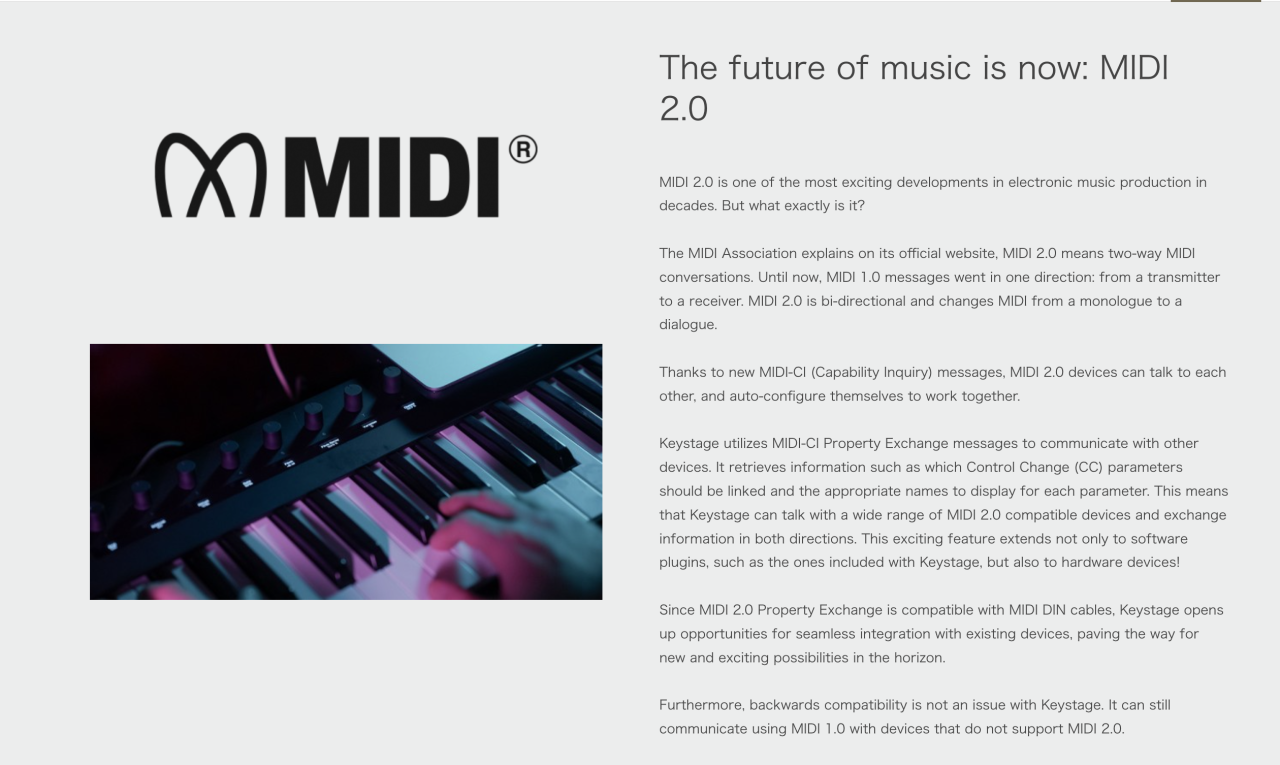New MIDI 2.0 Products Released-November, 2023

In the past few weeks, a number of MIDI Association member companies have released MIDI 2.0 products.
In this article, we’ll give a brief overview of those new MIDI 2.0 products, describe what their MIDI 2.0 features are and try to give an accurate picture of the MIDI 2.0 market.
The MIDI Association is currently undertaking a complete redesign of the MIDI.org website. By Winter NAMM 2024, our plan is to have a searchable database of MIDI 2.0 products. Companies will be able to upload information on new MIDI 2.0 products and MIDI users will be able to search for MIDI 2.0 products that work together.
MIDI 2.0 products can have different features sets. Some that support MIDI-CI Profiles and Property Exchange will work on MIDI 1.0 transports including 5 Pin DIN. Some require an operating system that supports MIDI 2.0 high resolution Voice Channel Messages, and some even need other products that support the same feature set to take full advantage of MIDI 2.0 features (for example, the demo at The MIDI Association booth in April 2023 included a Roland A88MKII, an Apple computer running Logic and AU and Synthogy’s Ivory Piano softsynth.
Native Instruments Kontrol S-Series MK3
Native Instruments has released the Kontrol S-Series MK3 which supports a number of MIDI 2.0 features. It supports USB MIDI 2.0, the new Universal MIDI Packet (UMP), MIDI 1.0 Voice Channel Messages in UMP format, and MIDI-CI Property Exchange including Channel List. It also supports Function Blocks. What is important to note is that even though it supports USB MIDI 2.0, it also has 5 PIN Din MIDI In and Out connectors.
If you have a Mac Computer that is running any operating system after Monterey, the internal native format for MIDI in the operating system is MIDI 2.0 High Resolution Voice Channel Messages.
When you plug in your MIDI 1.0 keyboard or interface, the OS is smart enough to know it is a MIDI 1.0 device and translates the internal MIDI 2.0 messages into MIDI 1.0 messages that your keyboard can understand.
People often worry if MIDI 2.0 will force them to buy a new cable, new software or new products. But literally for the last 2 years, people who owned Macs and updated their operating system have been using “MIDI 2.0”, they just didn’t know it or notice it because we spent so much time and effort making sure that things were backwards compatible.
So go ahead, connect a Sequential Circuits Prophet 600 or a Roland Jupiter 6 (the first two products ever connected by MIDI back in 1983) to your NI Kontrol S Series MK3 and they will still work just fine!
The S-Series MK3 features a large full color display, polyphonic aftertouch, and light guides for Smart Play. It also features software integration via NI’s next generation of NKS technology.
Features
- Unparalleled software integration with next-generation NKS technology for a direct and immersive connection to NI and partner instruments, effects, and sounds
- Choose between 49 or 61 semi-weighted keys, or 88 fully weighted hammer-action keys, all in an industry-leading Fatar keybed
- All three models come with polyphonic aftertouch as standard, plus Kontrol S88 is the first widely available hammer-action polyphonic aftertouch keyboard controller
- High-resolution full-color display screen for intuitive browsing, tweaking, and mixing
- Light Guide: RGB lights above each key highlight drum cells, key switches, chords, scales, and more
- Smart Play: See scales and modes on the Light Guide, play chord progressions and arpeggios with single keys, or map any scale to white keys only
- Anodized aluminum knobs and pitch and modulation wheels
by Native Instruments
Korg Keystage
Korg has released the Keystage controller which supports MIDI 2.0 via a manufacturer specific MIDI-CI Property Exchange including Channel List.
In designing MIDI 2.0, we wanted to allow companies to innovate without needing to get something standardized by the entire industry. So both Profiles and Property Exchange allow companies to use their companies SysEx ID to define a manufacturer specific Profile or Property Exchange.
That is exactly what Korg did with the Keystage. They use MIDI-CI Property Exchange to send JSON data between the computer and the Keystage. They can subscribe parameters so the communication is bi-directional and always gets updated. Because JSON is in human readable format, it can be easily displayed on the screen of the controller.
What’s important is that once companies have developed the core software for doing MIDI-CI that MIDI 2.0 software can be re-used in future products.
Keystage is at the forefront of keyboard innovation, being the first to truly tap into the potential of MIDI 2.0. Simply connect the keyboard to compatible software, and Keystage automatically assigns parameters and even displays their names on its crystal-clear OLED screens. Each screen is paired with a dedicated knob for real-time adjustments, meaning you always see the parameters assigned and their exact values, empowering you to make informed decisions and act on your musical instincts without breaking your creative stride.
by Korg
Roland A88 MKII Firmware Update
Roland announced the A88 MKII in 2020 and said that it was MIDI 2.0 ready and that the keyboard was capable of high resolution velocity and the and knobs were capable of sending 32 bit controllers. They have now made good on that promise by releasing a firmware update.
Roland is pleased to announce the immediate availability of a free MIDI 2.0 update for the A-88MKII MIDI Keyboard Controller. When Roland first introduced the A-88MKII at the Consumer Electronics Show (CES) in January 2020, the hardware was designed to be “ready for MIDI 2.0.” Now in 2023, MIDI 2.0 support is included with or coming very soon for all major computer and device operating systems.
With the free MIDI 2.0 update installed, A-88MKII owners will be ready to take advantage of dramatically increased musical expressivity as compatible instruments and apps become available. Pianos will perfectly reflect the most subtle keyboard playing techniques, orchestral sounds will be more acoustic and lifelike, and synthesizer textures will respond to performance gestures like never before.
Speaking to the A-88MKII MIDI 2.0 update, Roland Vice President of Customer Experience (CX) Paul McCabe notes, “Roland was a pioneering contributor to the original MIDI Standard over 40 years ago and has been deeply involved in the development of MIDI 2.0 since day one. Bringing MIDI 2.0 to life for musicians worldwide has long been a high priority for us, and we are pleased to make this happen with the free update for our A-88MKII MIDI Keyboard Controller.”
by Roland
Once again, we should point out that the A88 MKII which now supports MIDI 2.0 still includes good old 5 Pin DIN plugs. Now that companies are actually releasing products, people should feel very comfortable with the fact that MIDI 2.0 and MIDI 1.0 products will live side by side in their studios with no issues.
DAWs and Plugins Support for MIDI 2.0
There are now a number of DAWs on the market that have support for MIDI 2.0.
MultitrackStudio supports MIDI 2.0 and MIDI 2.0 VCM, MIDI-CI, Property Exchange Program List, MIDI 2.0 VCM with Articulations,
Logic supports MIDI 2.0 CVM and those can be passed to AU plugins,
Steinberg’s Cubase 13 and Nuendo 13 translate some MIDI 2.0 messages into VST3 format and supports high resolution velocity, CC, aftertouch, pitch bend, and poly pressure data. According to the Steinberg website both Nuendo 13 and Cubase 13 are ready for the widespread adoption of MIDI 2.0.
Ivory 3 supports High Resolution Velocity MIDI 2.0 Voice Channel Messages.
So does the Supreme Drums Taiko.
What’s next?
It’s clear that there will soon be many, many MIDI 2.0 products in the market.
As we mentioned before, we are working on a redesign of the MIDI.org website that will allow companies to enter their MIDI 2.0 products into a searchable database. If you want a preview of what that might look like just pop over to the MIDI Innovation Awards pages. Those entries were all done by the entrants filling out a web form with images, Youtube links and defined text fields that we can then use as dynamic content that automatically builds web pages after the entry is approved.
Next week, we will do another article that focuses on the tools and open source software that The MIDI Association and MIDI Association members are making available to support MIDI 2.0 developers.





